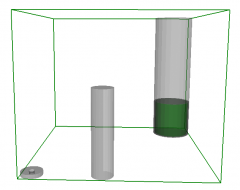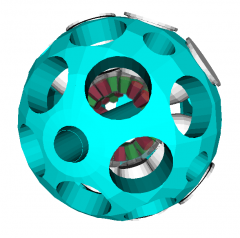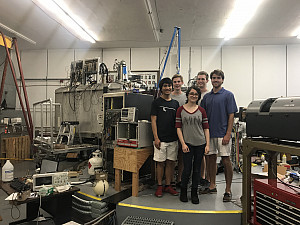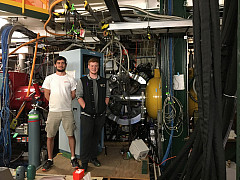Physics and Astronomy

Lew Riley
Professor of Physics
Pre-engineering Program Coordinator
Dr. Riley is a Professor of Physics at Ursinus. He received his B.S. in physics from Guilford College and his M.S. and Ph.D. in nuclear physics from Florida State University. He has involved undergraduates in research in experimental nuclear structure and detector simulation since 1998. His research program has been supported by grants from the National Science Foundation since 2000. He joined the Ursinus faculty in fall of 2002.
Department
Degrees
- B.S., Guilford College
- M.S., Ph.D., Florida State University
Teaching
PHYS121Q: Spacetime and Quantum Physics
PHYS122Q: Electromagnetism and Thermodynamics
PHYS201: Intermediate Mechanics
PHYS207W: Modern Physics
PHYS299: Mathematical Physics I
PHYS304: Thermal Physics
PHYS328W: Analog Electronics
PHYS401: Applications of Quantum Mechanics
PHYS410: Classical Mechanics
PHYS450W: Senior Seminar
PHYS111/112: General Physics I & II
CIE100: Common Intellectual Experience I
Research Interests
The Ursinus College Nuclear Structure Group collaborates with nuclear scientists on experiments at accelerator laboratories like FSU and FRIB. Our experimental work is focused on understanding the interplay between collective nuclear behavior, such as vibrations and rotations of the entire system, and the behavior of the individual protons and neutrons within it. We have done experimental work at the National Superconducting Cyclotron Laboratory at Michigan State University (NSCL) and the John D. Fox Superconducting Linear Accelerator Laboratory at Florida State University (FSU). The NSCL is nearing the end of a major upgrade to its driver accelerator and transitioning to become the Facility for Rare Isotope Beams (FRIB). The FRIB project is on track for its planned commissioning in 2022, and we are currently working on proposals for experiments there.
In addition to direct experimental work, we develop and maintain the computer code UCGretina, a simulation of the Gamma Ray Energy Tracking Array (GRETA) – an array of gamma-ray tracking detectors used in nuclear physics experiments at FRIB – and UCNaI, a simulation of the sodium iodide (NaI) scintillator detectors we use in the Advanced Laboratory at Ursinus.
Recent Work
In Summer 2022, Mill Heinze (UC Physics ’24) Dylan Symms (UC Physics ’24) were at the Fox Lab at Florida State University, using the 9 MV Tandem Van de Graaff accelerator to shoot a beam of deuterons at a 52Cr target. They studied the neutron transfer reaction 52Cr + d → 53Cr + p by measuring the momentums of protons produced in the reaction with the Super Enge Split Pole Spectrograph. Their work will improve the experimental picture of neutron shell structure beyond the N=28 major shell.

In Summer 2021, Matt Quirin (UC Pre-Engineering ’22) and Ray Saunders (UC Physics ’22) traveled to FSU to follow in Jess Nebel-Crosson’s (UC Physics ’21) footsteps to complete a neutron transfer measurement of 55Fe using the split-pole. They are investigating how the neutron single-particle states change with the addition of 4 protons relative to 51Ti.
In Spring 2021, Ray Saunders (UC ’22) worked on detector simulations with the geant4 Simulation Toolkit developed and maintained at CERN.

|

|
In Summer of 2019, Jess Nebel-Crosson (UC 2021) traveled to FSU to complete a neutron transfer measurement of 51Ti using the split-pole. In Summer of 2020, Jess worked on the analysis of the experiment, and is carrying the project forward as an Honors project in the 2020-2021 academic year.

In Summer of 2018, Lisa Skiles (UC 2019) and Max Liggett (UC 2021) traveled to the John D. Fox Superconducting Linear Accelerator Laboratory at Florida State University to participate in the commissioning of an Enge split-pole magnetic spectrograph recently relocated there from the Wright Nuclear Structure Laboratory at Yale University.

In October 2016, Ben Klybor (UC 2019), Lisa Skiles (UC 2019), Ethan Haldeman (UC 2018), and Sean Gregory (UC 2018) traveled to the National Superconducting Cyclotron Laboratory at Michigan State University (NSCL) to carry out an inverse-kinematics proton scattering measurement using the Ursinus College/NSCL liquid hydrogen target and the GRETINA gamma-ray tracking array. Data analysis will begin in summer of 2017.

|

|
Leah Jarvis (UC 2018) and Chase Stine (UC 2018) spent the summer of 2016 refining our simulations of the GRETINA gamma-ray tracking array by comparing simulations with scanning-table data collected in September 2015 at Lawrence Berkeley National Laboratory (LBNL). They spent a week at the NSCL visiting GRETINA where it is currently housed and working with collaborators there.

Recent Publications / Presentations with / by Students (student co-authors in boldface)
- 54Fe(d, p)55Fe and the evolution of single neutron energies in the N=29 isotones, L. A. Riley, I. C. S. Hay, L. T. Baby, A. L. Conley, P. D. Cottle, J. Esparza, K. Hanselman, B. Kelly, K. W. Kemper, K. T. Macon, G. W. McCann, M. W. Quirin, R. Renom, R. L. Saunders, M. Spieker, and I. Wiedenhöver, Phys. Rev. C 106, 064308 (2022), arXiv.2212.04384.
- 50Ti(d, p)51Ti: Single-neutron energies in the N = 29 isotones, and the N = 32 subshell closure, L. A. Riley, J. M. Nebel-Crosson, K. T. Macon, G. W. McCann, L. T. Baby, D. Caussyn, P. D. Cottle, J. Esparza, K. Hanselman, K. W. Kemper, E. Temanson, and I. Wiedenhöver, Phys. Rev. C 103, 064309 (2021).
- UCGretina GEANT4 simulation of the GRETINA Gamma-Ray Energy Tracking Array, L. A. Riley, D. Weisshaar, H. L. Crawford, M. L. Agiorgousis, C. M. Campbell, M.Cromaz, P. Fallon, A. Gade, S. D. Gregory, E. B. Haldeman, L. R. Jarvis, E. D. Lawson-John, B. Roberts, B. V. Sadler, C. G. Stine, Nucl. Instr. Meth. A1003, 165305 (2021), arXiv:2104.09986.
- Inverse-kinematics proton scattering from 42,44S, 41,43P, and the collapse of the N=28 major shell closure, L. A. Riley, D. Bazin, J. Belarge, P. C. Bender, B. A. Brown, P. D. Cottle, B. Elman, A. Gade, S. D. Gregory, E. B. Haldeman, K. W. Kemper, B. R. Klybor, M. A. Liggett, S. Lipschutz, B. Longfellow, E. Lunderberg, T. Mijatovic, J. Pereira, L. M. Skiles, R. Titus, A. Volya, D. Weisshaar, J. C. Zamora, and R. G. T. Zegers, Phys. Rev. C 100, 044312 (2019), arXiv:1910.07986.
- Single-Neutron Transfer to 50Ti, J. M. Nebel-Crosson, L. Riley, L. T. Baby, P. Cottle, J. C. Esparza, K. Hanselman, K. Kemper, G. McCann, I. Wiedenhoever, A. Conley, S. Lesher, R. Traas, A. Kuchera, G. Selby, Bull. Amer. Phys. Soc. 64, No. 12, HA.00006 (2019).
- Spectroscopy of 54Ti and the systematic behavior of low-energy octupole states in Ca and Ti isotopes, L. A. Riley, M. L. Agiorgousis, T. R. Baugher, D. Bazin, R. L. Blanchard, M. Bowry, P. D. Cottle, F. G. DeVone, A. Gade, M. T. Glowacki, K. W. Kemper, J. S. Kustina, E. Lunderberg, D. M. McPherson, S. Noji, J. Piekarewicz, F. Recchia, B. V. Sadler, M. Scott, D. Weisshaar, and R. G. T. Zegers, Phys. Rev. C 96, 064315 (2017), arXiv:1712.00411.
- Inverse-kinematics proton scattering from 41P, B.R. Klybor, S.D. Gregory, E.B. Haldeman, L.A. Riley, L.M. Skiles, P.D. Cottle, K.W. Kemper, D. Bazin, J. Belarge, P.C. Bender, B. Elman, A. Gade, S. Lipschutz, B. Longfellow, E. Lunderberg, T. Mijatovic, J. Pereira, R. Titus, D. Weisshaar, J.C. Zamora, and, R.G.T. Zegers, Bull. Amer. Phys. Soc. 62, No. 11 EA.00172 (2017).
- Inverse-kinematics proton scattering from 43P, L.M. Skiles, S.D. Gregory, E.B. Haldeman, B.R. Klybor, L.A. Riley, P.D. Cottle, K.W. Kemper, D. Bazin, J. Belarge, P.C. Bender, B. Elman, A. Gade, S. Lipschutz, B. Longfellow, E. Lunderberg, T. Mijatovic, J. Pereira, R. Titus, D. Weisshaar, J.C. Zamora, and, R.G.T. Zegers, Bull. Amer. Phys. Soc. 62, No. 11 EA.00173 (2017).
- Determination of the Thickness of the Back Dead-Layer of GRETINA Crystals via Comparisons of Measured Photopeak Efficiencies with GEANT4 Simulations, L. R. Jarvis, C. G. Stine, and L. A. Riley, Bull. Amer. Phys. Soc. 61, No. 13 EA.00112 (2016).
- Octupole strength in the neutron-rich calcium isotopes, L. A. Riley, D. M. McPherson, M. L. Agiorgousis, T. R. Baugher, D. Bazin, M. Bowry, P. D. Cottle, F. G. DeVone, A. Gade, M. T. Glowacki, S. D. Gregory, E. B. Haldeman, K. W. Kemper, E. Lunderberg, S. Noji, F. Recchia, B. V. Sadler, M. Scott, D. Weisshaar, and R. G. T. Zegers, Phys. Rev. C 93, 044327 (2016), arXiv:1604.08624.